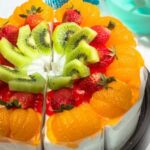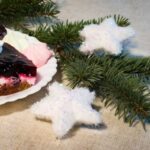Are you looking to create a show-stopping dessert for your next celebration? Learning how to decorate a flat cake can add a touch of artistry and flair to your baking skills.
From choosing the right cake base to adding decorative elements, there are various techniques that can help you achieve a beautifully decorated flat cake. In this article, we will explore the step-by-step process of decorating a flat cake, including tips for creating smooth and even surfaces, using different frosting techniques, and troubleshooting common decorating mistakes.
When it comes to decorating a flat cake, the first step is to choose the right cake base. Whether you opt for a classic vanilla sponge or a rich chocolate fudge, selecting the perfect base sets the stage for your decoration journey. Next, we’ll delve into leveling and filling the layers of the cake, as well as using different frosting techniques to achieve that flawless finish.
In addition to mastering the basics of cake decoration, we’ll also explore how to add decorative elements such as flowers, fruits, and other edible embellishments that can take your flat cake from ordinary to extraordinary. Alongside this, we’ll provide expert tips on troubleshooting common decorating mistakes so that you can confidently tackle any challenges that may arise during the decorating process.
Get ready to elevate your baking game with our comprehensive guide on how to decorate a flat cake in style.
Choosing the Right Cake Base
When it comes to decorating a flat cake, choosing the right cake base is crucial for the success of your creation. Here are some tips for selecting the perfect cake base for your decorating project:
1. Consider the flavor: Whether you prefer a classic vanilla, rich chocolate, or fruity citrus flavor, it’s important to choose a cake base that complements the overall taste of your decorated creation.
2. Texture matters: The texture of the cake base can make a big difference in how well it holds up to decorating techniques. A sturdy and firm cake base is ideal for intricate designs and decorative elements.
3. Size and shape: Depending on the theme or occasion, you may want to consider using different sizes and shapes for your cake base. For example, a round cake base works well for floral designs, while a rectangular or square base is perfect for creating patterns and shapes.
Choosing the right cake base sets the stage for successful cake decoration. Whether you opt for a moist and flavorful sponge cake or a dense and rich chocolate base, ensuring that it complements your overall design vision will result in a stunning final product.
Leveling and Filling the Cake Layers
Leveling the Cake Layers
Before you can begin decorating your flat cake, it’s essential to ensure that the layers are level. Use a long serrated knife or a cake leveler to carefully slice off any domed tops from each layer. This will provide a smooth surface for stacking and frosting.
Filling the Cake Layers
Once your cake layers are leveled, it’s time to add filling between each layer. Choose a delicious filling that complements the flavor of your cake, such as fruit preserves, flavored buttercream, or chocolate ganache. Spread an even layer of filling on top of one cake layer, then gently place the next layer on top. Repeat this process for multiple layers, being careful not to overfill and cause the layers to slide.
Building a Sturdy Structure
To prevent your cake from toppling over during decoration or serving, consider using wooden dowels or plastic straws inserted into the center of the cake to provide additional support for multi-layered cakes. This will help maintain the stability of your finished creation and ensure that it remains intact until it is served.
By ensuring that your cake layers are leveled and filled properly, you’ll create a sturdy foundation for decorating and guarantee a delightful experience for everyone who enjoys your beautifully decorated flat cake.
Using Different Frosting Techniques for a Flat Cake
When it comes to decorating a flat cake, choosing the right frosting and using different techniques can make a big difference in the final result. The frosting is not only important for adding flavor to the cake but also for creating a smooth and appealing surface. There are various frosting options and techniques that can be used to achieve different looks and textures.
Buttercream Frosting
One of the most popular choices for decorating flat cakes is buttercream frosting. This type of frosting is creamy, easy to work with, and can be flavored and colored in countless ways. When using buttercream frosting, it’s essential to prepare it to the right consistency for spreading or piping onto the cake. Using a spatula or offset spatula can help achieve an even layer of buttercream on the cake’s surface.
Fondant Covering
For a more polished and smooth finish, fondant can be used to cover the entire cake. Fondant is a pliable sugar paste that can be rolled out into a thin sheet and draped over the cake. It creates a flawless base for adding decorative elements such as fondant flowers, shapes, or intricate designs. Working with fondant requires some skill and practice, but it allows decorators to achieve clean lines and sharp edges on their flat cakes.
Naked Cake Technique
The naked cake technique has gained popularity for its rustic and understated look. Instead of fully covering the cake with frosting, this technique involves spreading a thin layer of icing between each cake layer while leaving the sides exposed, giving it a “naked” appearance. This style suits casual or bohemian-themed events and allows bakers to showcase the inside layers of the cake while adding simple adornments like fresh fruit or edible flowers on top.
Adding Decorative Elements to the Cake
Once you have chosen the right cake base, leveled and filled the layers, and applied the frosting, it’s time to add decorative elements to your flat cake. Whether you’re decorating for a special occasion or just for fun, there are countless ways to enhance the look of your cake.
One popular way to add decorative elements is by using fresh fruits and berries. Not only do they provide vibrant colors and natural sweetness, but they also add a refreshing touch to your cake. You can strategically place slices of strawberries, kiwi, or blueberries on top of the cake or around the edges for a beautiful and appetizing effect.
Another option for adding decorative elements is incorporating edible flowers into your design. Edible flowers such as pansies, roses, violets, and lavender not only bring an elegant and romantic touch to your cake but also offer a subtle floral flavor. Be sure to research which flowers are safe for consumption and free from pesticides before using them as decorations.
For those who prefer a more playful approach to decorating their cakes, consider incorporating chocolate shavings, sprinkles, or edible glitter. These fun and whimsical elements can be used to create eye-catching designs or simply add a bit of sparkle and pizzazz to your flat cake.
| Decorative Element | Description |
|---|---|
| Fresh Fruits and Berries | Adds vibrant colors and natural sweetness |
| Edible Flowers | Brings an elegant touch and offers subtle floral flavor |
| Chocolate Shavings, Sprinkles, or Edible Glitter | Creates eye-catching designs or adds sparkle and pizzazz |
Tips for Creating Smooth and Even Surfaces
To create a perfectly smooth and even surface on your flat cake, there are a few tips and techniques that can help you achieve professional-looking results. One of the most important steps in achieving a smooth surface is to ensure that your cake layers are level and even before adding any frosting. Using a long serrated knife or cake leveler, carefully trim any uneven areas and make sure each layer is the same height.
Once your cake layers are level, it’s time to apply a crumb coat of frosting. This thin layer of frosting will help seal in any loose crumbs and provide a smooth base for the final layer of frosting. Use an offset spatula to spread a thin layer of frosting over the entire cake, making sure to fill in any gaps or uneven areas.
After applying the crumb coat, place the cake in the refrigerator for at least 30 minutes to allow the frosting to set. Once the crumb coat is firm, you can then apply the final layer of frosting. Start by adding a generous amount of frosting to the top of the cake and use an offset spatula to spread it evenly over the top and sides of the cake.
Take your time to ensure that the frosting is smooth and level, using long strokes with the spatula for best results. Following these tips will help you achieve a smooth and even surface on your flat cake, providing a perfect canvas for adding decorative elements.
Decorating With Textures and Patterns
When it comes to decorating a flat cake, adding textures and patterns can take your creation to the next level. Whether you’re looking to add some dimension to your design or simply want to make your cake more visually appealing, there are numerous ways to incorporate textures and patterns into your decorating process.
To start, consider using different types of frosting tips to create textured designs on the surface of the cake. You can use a star tip for a simple yet elegant textured look, or get creative with a petal or leaf tip for more intricate patterns. Additionally, using a comb or spatula to create gentle waves or ridges in the frosting can add an extra element of visual interest.
Incorporating patterns into your cake decoration is another way to elevate its appearance. From classic polka dots and stripes to more elaborate floral designs or geometric shapes, there are countless options for adding eye-catching patterns to your flat cake. Consider using stencils or templates as guides for creating precise and symmetrical patterns, or simply freehand your design for a more organic and unique look.
In addition, don’t be afraid to mix and match different textures and patterns within the same cake design. Combining smooth surfaces with textured accents or layering various patterns can create a visually dynamic and captivating finished product. Experiment with different techniques and tools to discover what works best for achieving the textured and patterned look you desire for your flat cake.
Final Touches and Presentation Ideas
Once the flat cake is frosted and decorated, it’s time to add the final touches and presentation ideas that will make your creation truly stand out. One great way to add a professional touch to your flat cake is by creating a beautiful border around the edges using piping bags and different frosting tips. For a more intricate design, consider using edible flowers, chocolate shavings, or fresh fruit as a decorative border.
Another idea for final touches on a flat cake is to incorporate different textures and finishes. You can do this by using a variety of tools such as combs, spatulas, and stencils to create interesting patterns and designs in the frosting. Consider experimenting with both smooth and textured finishes on different areas of the cake for added visual interest.
When it comes to presenting your flat cake, there are many creative ideas to consider. If you’re making the cake for a special occasion like a birthday or anniversary, consider adding personalized decorations such as fondant cutouts or edible images that reflect the theme or the recipient’s interests.
Additionally, think about incorporating height into your presentation by stacking multiple layers of flat cakes or adding decorative elements like cake toppers or candles. These final touches will not only enhance the visual appeal of your creation but also make it more memorable for those enjoying it.
Troubleshooting Common Decorating Mistakes
Decorating a flat cake can be a fun and rewarding experience, but it doesn’t always go as planned. There are common decorating mistakes that can occur when working with a flat cake, but the good news is that many of these issues can be easily fixed.
One common mistake when decorating a flat cake is uneven frosting. This can happen if the cake layers are not level or if the frosting is applied too thick in some areas and too thin in others. To fix this issue, consider using a cake leveler to ensure your layers are even, and use a frosting spatula to spread the frosting evenly across the cake’s surface.
Another common mistake is air bubbles in the frosting. This can give your cake an unattractive appearance and texture. To avoid air bubbles, try gently tapping the sides of the cake after applying the frosting to help release any trapped air. Additionally, you can smooth out the frosting with a Viva paper towel or use a bench scraper for a flawless finish.
Lastly, an issue that decorators often face is smudged or messy decorations. It’s important to wait until the cake is completely cooled before adding any decorative elements such as piping designs or edible embellishments. If you find that your decorations are still smudging, try refrigerating the cake for a short time to allow the frosting to set before adding any additional details.
By being aware of these common decorating mistakes and knowing how to troubleshoot them, you can ensure that your flat cake turns out beautifully decorated and ready to impress at any event or celebration.
Conclusion and Recap of Decorating Tips
Decorating a flat cake can be a fun and creative process, allowing you to express your personality and style. From choosing the right cake base to adding decorative elements and final touches, there are many tips and techniques that can help you create a stunning dessert. By following these decorating tips, you can elevate your flat cakes and impress your friends and family with your baking skills.
One of the key aspects of decorating a flat cake is creating smooth and even surfaces. This can be achieved by leveling and filling the cake layers properly, as well as using different frosting techniques. Whether you prefer a simple buttercream frosting or more intricate designs such as textures and patterns, there are endless possibilities for making your flat cake visually appealing.
In addition to the visual aspect, presentation plays an important role in the overall impact of your decorated cake. By paying attention to final touches and presentation ideas, such as adding fresh fruit or edible flowers, you can take your flat cake to the next level. Remember that practice makes perfect, so don’t be discouraged by common decorating mistakes. With time and experience, you’ll become more confident in creating beautifully decorated flat cakes for any occasion.
Frequently Asked Questions
How Do You Make a Flat Cake Look Good?
Making a flat cake look good involves several techniques. Firstly, ensure that the cake is leveled properly before frosting to create a smooth surface.
Use a crumb coat of frosting to seal in any loose crumbs, then apply a final layer of frosting evenly and smoothly. Adding decorative elements such as fresh fruit, edible flowers, or chocolate shavings can also enhance the appearance of the cake.
How Do I Stop My Cake From Doming?
To prevent a cake from doming, it’s important to make sure the oven temperature is accurate and that the cake batter is evenly distributed in the pan. Using cake strips around the pans can help distribute heat more evenly and prevent doming. Additionally, avoid overmixing the batter, which can lead to air pockets and uneven rising.
How Do You Make a Plain Cake Look Fancy?
There are many ways to make a plain cake look fancy without much effort. Adding a simple glaze or frosting drizzle with a contrasting color can give an elegant touch.
Dusting the top of the cake with powdered sugar or cocoa powder through a lace doily or stencil can create a beautiful design. Finally, adding sliced fruit, nuts, or a sprinkle of edible glitter can transform a plain cake into an eye-catching dessert centerpiece.

Welcome to my blog about home and family. This blog is a place where I will share my thoughts, ideas, and experiences related to these important topics. I am a stay-at-home mom with two young children. I hope you enjoy reading it! and may find some helpful tips and ideas that will make your home and family life even better!





